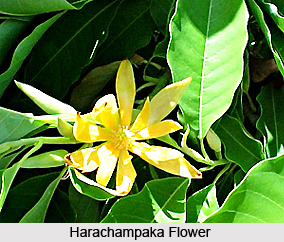 Harachampaka is a climbing shrub and is considered as a medicinal plant in India. These shrubs are native to the dry forests of southern India and are cultivated throughout India for its fragrant flowers. Botanical name of this shrub is Artabotrys hexapetalus (L f.) Bhandari. The major common names of the Harachampaka shrub are Katchampa in Bengali, Climbing ylang-ylang in English, harachampa in Hindi and harachampaka, madanah, nilachampaka, and phalasampenga in Sanskrit.
Harachampaka is a climbing shrub and is considered as a medicinal plant in India. These shrubs are native to the dry forests of southern India and are cultivated throughout India for its fragrant flowers. Botanical name of this shrub is Artabotrys hexapetalus (L f.) Bhandari. The major common names of the Harachampaka shrub are Katchampa in Bengali, Climbing ylang-ylang in English, harachampa in Hindi and harachampaka, madanah, nilachampaka, and phalasampenga in Sanskrit.
The older stems of Harachampaka shrub are very thick, covered with smooth grey bark with thick, woody, and pointed spines. These spines are 2cm to 4 cm long. The lengths of the leaves vary from 5cm to 20 cm and are 2-5 cm in width. These are narrowly elliptical, glabrous, shining, apex shortly acuminate with acute base. Flowers are fragrant; appear in solitary or in pairs with yellowish-green colour. The fruits or berries of Harachampaka shrub are ovoid in shape. The length of the fruits differ which vary from 2cm to 3.8 cm and 2.2 cm in diameter. On maturing these fruit become yellow coloured and bear 1.3 cm long seeds.
The Harachampaka shrub has a great medicinal value. The flowers of this shrub are used to prepare a stimulating tea-like beverage. In Ayurveda the flowers are used for treating vomiting, biliousness, diseases of the blood, heart and bladder, itching, leuco-derma, headache and erysipelas. Leaves of this shrub are also used to treat cholera.
This article is a stub. You can enrich it by adding more information to it. Send your write up at contentindianetzone.com



















